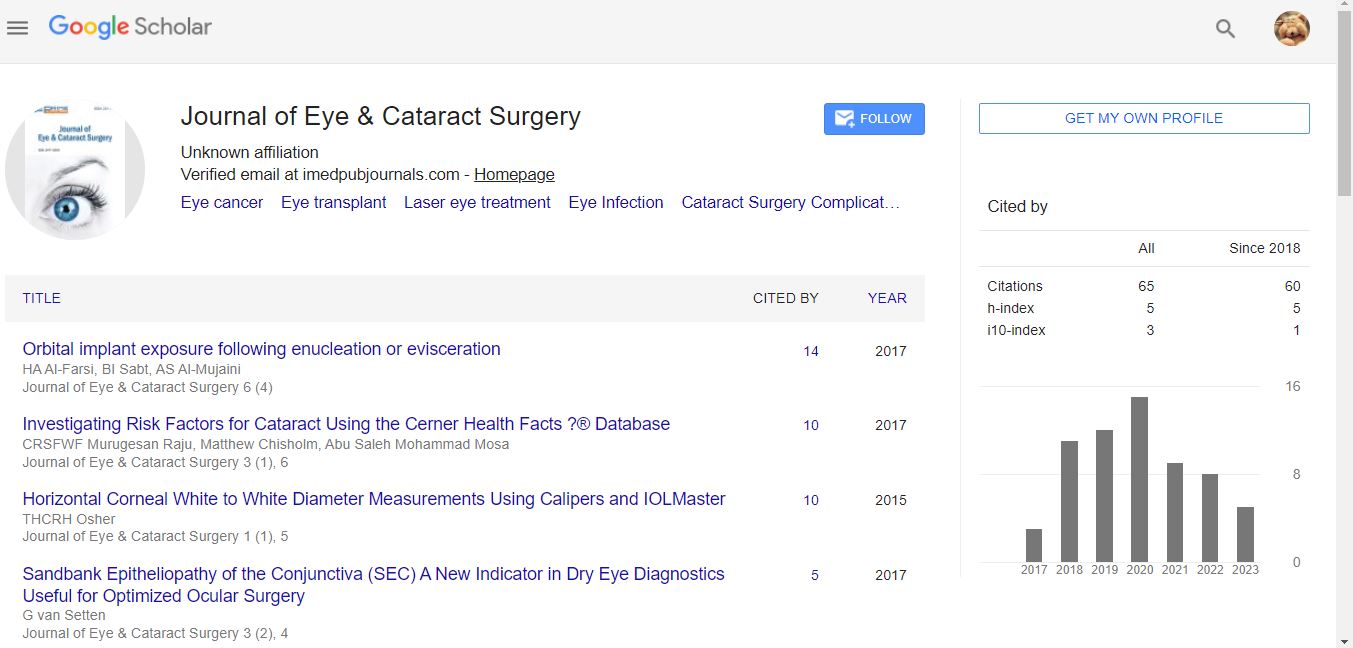Perspective - (2024) Volume 10, Issue 3
An In-Depth Exploration of Corneal Cross-Linking: A Revolutionary Technique for Managing Corneal Disorders
Stevens Freya*
Department of Ophthalmology, University of Medical Sciences, USA
*Correspondence:
Stevens Freya,
Department of Ophthalmology, University of Medical Sciences,
USA,
Email:
Received: 02-Sep-2024, Manuscript No. IPJECS-24-21687;
Editor assigned: 04-Sep-2024, Pre QC No. IPJECS-24-21687 (PQ);
Reviewed: 18-Sep-2024, QC No. IPJECS-24-21687;
Revised: 23-Sep-2024, Manuscript No. IPJECS-24-21687 (R);
Published:
30-Sep-2024, DOI: 10.36648/2471-8300.10.3.27
Introduction
Corneal cross-linking is an innovative therapeutic technique
designed to strengthen the cornea, primarily used to treat
keratoconus, a progressive disorder characterized by thinning
and bulging of the cornea. This condition can lead to significant
visual impairment, making early intervention crucial enhances
the structural integrity of the cornea by promoting the
formation of new cross-links between collagen fibres, thereby
stabilizing the cornea and preventing further progression of
the disease. Understanding the mechanisms, applications, and
advancements in corneal cross-linking is essential for both
healthcare providers and patients navigating the complexities
of corneal disorders. The fundamental principle behind corneal
cross-linking involves the application of riboflavin drops to the
cornea, followed by exposure to ultraviolet light.
Description
Riboflavin serves as a photosensitizer that, when activated
by UV light, generates reactive oxygen species, leading to the
formation of covalent bonds between collagen fibres in the
corneal stroma. This process results in increased stiffness and
strength of the corneal tissue, effectively halting the progression
of keratoconus and improving visual acuity can be performed
in various ways, with the most common method being the
epithelium-off technique. In this approach, the outer layer
of the cornea is removed to allow for better penetration of
riboflavin. While this method often yields excellent results,
it does involve a longer recovery time and potential for postoperative
discomfort. The choice of technique depends on the
individual patient’s condition, corneal thickness, and surgeon
preference. The indications for corneal cross-linking extend
beyond keratoconus. It has also shown promise in treating
other corneal conditions, such as corneal ectasia following
refractive surgery and post-LASIK corneal steepening. These
applications have expanded the potential to be a valuable tool
in the management of a broader spectrum of corneal disorders.
These can include post-operative pain, infection, and haze,
which may affect visual clarity. However, with careful patient
selection and adherence to proper protocols, these risks can
be minimized. In recent years, advancements in technology
and techniques have further enhanced the safety and efficacy
leading to improved patient outcomes. The post-operative
care for patients undergoing corneal cross-linking is critical to
ensure optimal healing and prevent complications. Patients are
typically advised to use topical antibiotics and anti-inflammatory
medications, along with lubricating eye drops to promote
comfort during the recovery process. Regular follow-up visits
are essential for monitoring corneal healing and visual acuity,
allowing healthcare providers to address any concerns that may
arise. Education and awareness about corneal cross-linking are
vital for both patients and practitioners.
Conclusion
Furthermore, healthcare providers must stay updated on the
latest advancements and research to offer the most effective
treatment options. In conclusion, corneal cross-linking represents
a significant advancement in the management of keratoconus
and other corneal disorders. By enhancing the structural
integrity of the cornea, this technique provides patients with a
viable option to preserve their vision and quality of life. Ongoing
research and technological innovations will continue to refine
methods, expanding its applications and improving outcomes for
patients worldwide. As awareness grows and more individuals
seek treatment for corneal disorders, corneal cross-linking will
play an increasingly important role in modern ophthalmology,
offering hope and improved vision for those affected.
Citation: Freya S (2024) An In-depth Exploration of Corneal Cross-linking: A Revolutionary Technique for Managing Corneal Dis�orders. J Eye Cataract Surg. 10:27.
Copyright: © 2024 Freya S. This is an open-access article distributed under the terms of the Creative Commons Attribution Li�cense, which permits unrestricted use, distribution, and reproduction in any medium, provided the original author and source
are credited

